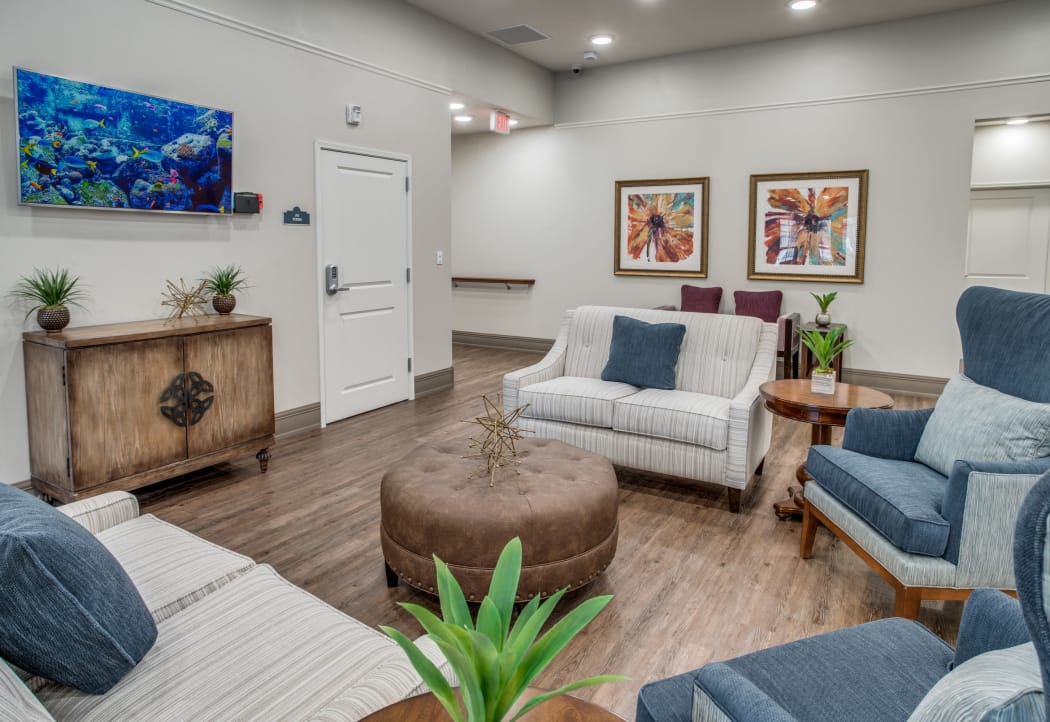Charlotte Memory Care: Expert Assisted Living for Memory Assistance
Wiki Article
Developing a Safe and Encouraging Environment: In-Home Memory Treatment Basics
Establishing a nurturing and protected atmosphere for individuals needing in-home memory treatment is vital to their well-being and lifestyle. From making certain security within the home to employing reliable interaction methods and implementing memory-friendly design components, there are necessary components that add to an alternative care strategy. By focusing on developing a helpful ecosystem that satisfies the unique demands of those with memory impairments, caretakers can significantly boost the day-to-day experiences of their liked ones.
Safe Living Environment
Creating a safe and hazard-free living environment is critical when offering in-home memory care for people with cognitive problems. Ensuring the safety of the individual with memory loss is important to avoid mishaps and promote a feeling of wellness.Moreover, it is essential to mount safety features such as grab bars in restrooms and handrails along staircases to offer support and avoid mishaps. Furthermore, making use of technology such as motion sensing units and alarm systems can signal caretakers if the individual wanders or is in distress. Producing a safe living environment also entails implementing strategies to stop wandering, such as using door alarm systems or locks to restrict accessibility to dangerous locations. By focusing on security steps and removing possible risks, caretakers can give a safe and secure and encouraging setting for individuals with cognitive impairments obtaining at home memory care.
Reliable Communication Strategies
Applying customized interaction strategies is crucial in promoting purposeful communications with people with cognitive impairments in the context of at home memory treatment. Reliable interaction plays an essential duty in creating a helpful setting that improves the well-being and high quality of life for people with memory issues. When interacting with a person experiencing cognitive decline, it is essential to use clear and simple language, preserve a calmness and favorable tone, and offer visual hints to aid understanding.One key method is to exercise active listening, showing empathy, persistence, and regard throughout conversations. Non-verbal cues such as facial expressions and body movement can additionally assist share understanding and assistance. Additionally, using reminiscence treatment by making use of or reviewing past experiences songs and art can take advantage of lasting memories, triggering links and boosting engagement.
Moreover, incorporating routine regimens and regular interaction patterns can give a feeling of knowledge and security for people with memory disabilities. By executing these communication techniques, caregivers can establish meaningful connections and promote a feeling of convenience and count on the at home memory care setting.
Memory-Friendly Design
Offered the value of developing a helpful environment for people with memory concerns with efficient communication strategies, the incorporation of memory-friendly design components in the home ends up being critical in enhancing their daily experiences and overall health. Memory-friendly style concentrates on boosting safety, comfort, and independence for people with cognitive disabilities. Easy modifications can make a substantial difference, such as using contrasting shades to enhance exposure and reduce complication, including clear signs to assist navigating, and lessening mess to prevent sensory overload.
Incorporating acquainted elements from the person's past, such as personal pictures or favorite items, can evoke favorable memories and produce a feeling of knowledge. By integrating these memory-friendly design elements, caregivers can offer a helpful and secure living space that makes it possible for people with memory issues to keep their self-reliance and top quality of life. Charlotte Memory Care.
Daily Regimen Preparation
When establishing a daily routine for people with memory concerns, cautious planning is important to support their cognitive feature and total health. Developing an organized routine can help in reducing anxiety, confusion, and disorientation frequently experienced by those with memory disabilities. Begin by integrating acquainted tasks that line up with the person's preferences and passions. Uniformity in daily regimens Check Out Your URL can provide a complacency and security, aiding in the conservation of cognitive abilities.It is important to enable adequate time for each and every activity, minimizing the requirement to hurry and avoiding prospective aggravation. Easy tasks like meal times, individual care, drug monitoring, and workout should be integrated into the regimen. In addition, incorporating regular periods of remainder and leisure can prevent exhaustion and agitation. Versatility is crucial, as some days might call for changes based upon the individual's mood and power degrees. On a regular basis reviewing and adjusting the day-to-day schedule will certainly assist ensure its performance in advertising a reassuring and positive environment for individuals with memory challenges.
Support Group Implementation
Developing a robust network of helpful individuals plays a critical role in enhancing the top quality of care and well-being for individuals calling for memory assistance. Member of the family, buddies, medical care experts, and area sources can all add to developing a strong support group. Interaction among these individuals is important to make certain that the needs of the specific with memory difficulties are fulfilled successfully.Member of the family are frequently the primary caregivers and develop the foundation of the support group. They supply everyday treatment, emotional assistance, and companionship. When required to avoid fatigue and ensure the ideal possible care for their enjoyed one., it is important for household members to look for aid and respite.
In enhancement to family support, entailing healthcare experts such as doctors, therapists, and registered nurses can supply specialized care and guidance. These experts can supply valuable insights, medical advice, and help in taking care of the person's problem.

Conclusion
In final thought, producing a supportive and secure environment for individuals link with memory care needs is vital for their wellness. By establishing a risk-free living environment, utilizing effective communication strategies, incorporating memory-friendly layout elements, planning daily routines, and implementing a strong support group, caretakers can help enhance the high quality of life for those with memory loss. These vital elements interact to develop a nurturing and encouraging setting that advertises self-reliance and boosts overall quality of life.Creating a hazard-free and protected living environment is paramount when giving at home memory care for individuals with cognitive disabilities. By prioritizing safety and security measures and getting rid of possible risks, caretakers can offer a safe and encouraging setting for go to website people with cognitive disabilities getting at home memory treatment.
Establishing a durable network of helpful individuals plays a crucial function in enhancing the top quality of care and well-being for individuals requiring memory assistance - Charlotte Memory Care. Communication amongst these individuals is essential to make certain that the requirements of the individual with memory challenges are satisfied efficiently

Report this wiki page